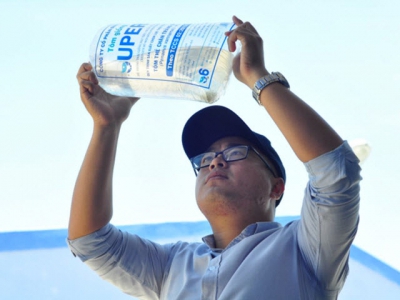Enhancing environmental monitoring and warning capabilities in shrimp seeds production hub

Taking advantage of favorable environmental conditions, temperature, and pure sea water, Ninh Thuan province has developed into the country's top producer of shrimp seeds.
Currently, shrimp seeds production in Ninh Thuan accounts for 35% of the country's shrimp seed production. Photo: Minh Hau.
The largest hub for the manufacturing of shrimp seeds in the nation
After 30 years of formation and development, the shrimp seeds production industry in Ninh Thuan has thrived, significantly contributing to the stability of the society, providing more employment for people, and assisting in the collection of local taxes.
According to Ninh Thuan agricultural sector reports, the locality is home to 450 facilities with 1,200 shrimp seed production camps, including a number of leading corporations and businesses, including C.P Vietnam Livestock Joint Stock Company, Minh Phu Seafood Group Joint Stock Company, Uni - President Vietnam Co., Ltd., and Viet Uc Group. In 2020, this location produced about 40 billion seeds, accounting for 35% of the country's shrimp seed output.
To achieve these goals, Ninh Thuan and the agriculture sector have implemented a series of solutions over the last few years to attract businesses to invest in production and planning of the culture area, brand building, market expansion, as well as environmental and disease monitoring and warning systems to support production activities.
As stated by the Deputy Director of the Ninh Thuan Subdepartment of Fisheries, environmental monitoring and warning systems in shrimp farming facilities are critical for early detection of issues. Adverse variables enable aquaculture hatcheries to be proactive in their preventive and treatment efforts, guaranteeing the production of high-quality water.
As a result, monitoring, monitoring, and warning of the environment and illnesses in concentrated aquatic seed production regions is always carried out in a timely manner, benefiting production operations on a regular basis.
“Each year, the Ninh Thuan Fisheries Sub-Department prepares and organizes the collection of environmental monitoring samples in concentrated aquatic seed production regions on a periodic or intense basis to provide timely service for the enterprise's shrimp seed production activities,” Tuan said.
The results indicated that the salinity, alkalinity, and pH of coastal saltwater in aquaculture planting sites in Ca Na, An Hai, Tri Hai, Nhon Hai, and Thanh Hai communes were within permissible limits as defined by QCVN 10-MT:2015/BTNMT.
The present challenge is that Ninh Thuan has not yet implemented an automated environmental monitoring system in the province's big concentrated aquatic seed producing regions owing to a lack of funds.
Investing in an environmental monitoring system as a priority
With the goal of establishing a high-tech shrimp seed production area in the concentrated shrimp seed production regions of An Hai and Nhon Hai, as well as broodstock production in Son Hai, among others, environmental preservation in concentrated aquatic seed production areas is deemed essential.
To ensure the long-term viability of these concentrated shrimp seed production regions, in addition to the overall plan, it is essential to continue to strengthen the capability of environmental monitoring and warning in aquaculture breeding areas. Utilize cutting-edge technologies. Continue to invest in the construction of automated environmental monitoring stations at sea; analyzing water samples using cutting-edge techniques and technology to monitor and rigorously regulate environmental variables in order to guarantee the highest quality water supply for shrimp seed production.
Applying advanced, environmentally friendly technologies to shrimp seed production without the use of harmful chemicals and antibiotics; promoting propaganda and advocacy to increase individual and organizational awareness and responsibility for environmental protection and sustainable development; wastewater from shrimp hatcheries must be treated locally by hatchery facilities.
Socialization may be used to provide and treat saltwater and freshwater sources for manufacturing, as well as centralized wastewater treatment. Advanced techniques and contemporary technology are used to treat waste water before it is released into the surrounding environment. Simultaneously, enhance environmental inspection, control, and supervision in shrimp seed production; severely prosecute enterprises that violate environmental protection laws.
Du Ngoc Tuan, Deputy Director of the Ninh Thuan Fisheries Sub-Department, said, "An Hai concentrated aquaculture seed production area covers an area of 125 hectares, making it the province's biggest of its type, with MARD investing in a number of infrastructure projects in 2006. It has attracted over 140 businesses manufacturing aquatic breeds, mostly shrimp seed, with an annual production of 13-15 billion seeds and ambitions to grow to over 200ha.
The Nhon Hai concentrated aquatic seed production region (Ninh Hai district) covers an area of about 100 hectares and is home to more than 60% of the province's shrimp seed production facilities, accounting for approximately 60% of the province's total shrimp seed production facilities. Production of shrimp seeds in the province. The Son Hai broodstock production area covers about 40 hectares and is currently home to a number of units.
Related news
 Seafood exports forecasted to prosper in the fourth quarter
Seafood exports forecasted to prosper in the fourth quarter Although exports in August decreased, the seafood industry is forecasted to prosper in the fourth quarter of 2021, with the opportunity to complete the target
 Great opportunity for pangasius exports
Great opportunity for pangasius exports Under difficult conditions, pangasius exports to the Mexican market grew impressively with three-digit numbers, becoming the leading export market of Vietnamese
 Removing difficulties for the shrimp industry with the peak of exports at the end
Removing difficulties for the shrimp industry with the peak of exports at the end With many orders and good market signals, shrimp processing and exporting enterprises are looking forward to restoring production to take advantage